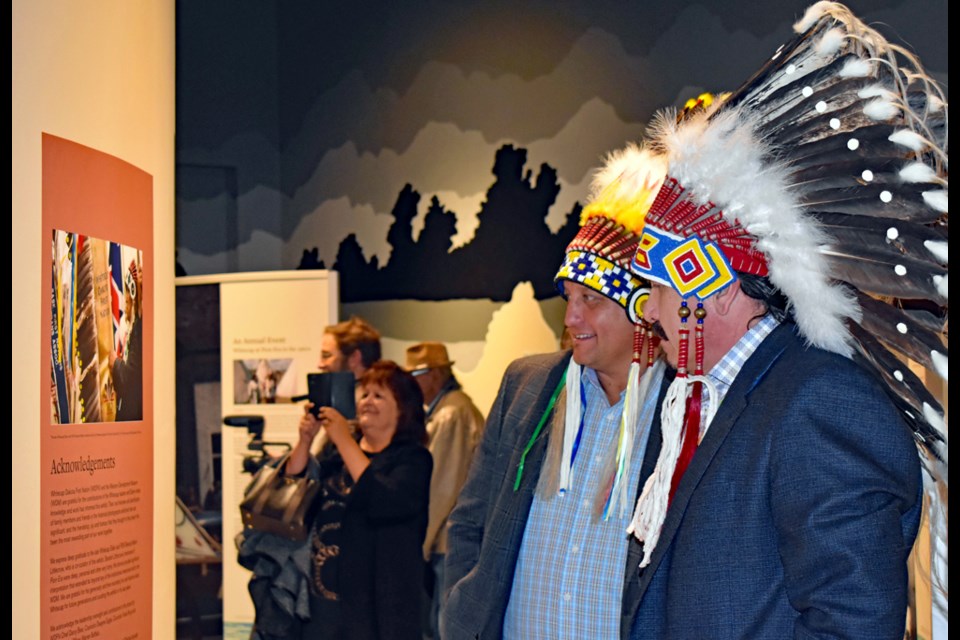SASKATOON — Whitecap Dakota First Nation Chief Darcy Bear said the permanent exhibit showing the lives of members of their community more than 60 years ago acknowledges a long-standing partnership between their people and the first settlers in the prairies.
Bear was with other dignitaries during Tuesday night’s opening of the Wapaha SkÌ„a Oyate: Living Our Culture, Sharing our Community at Pion-Era 1955-1969 exhibit at the Western Development Museum. The exhibit was a joint project by the WDFN and WDM.
Bear said that partnership began before city of Saskatoon was established a year after John Lake arrived from Eastern Canada to survey the west as commissioner of the Temperance Colonization Society of Toronto.
“In 1882, John Lake was looking for a place to put his temperance colony. He sought the advice of Chief Whitecap and he picked the location of the colony would settle. It took the city 125 years when they finally acknowledged the contribution made by Chief Whitecap,” said Bear.
“Finally, Chief Whitecap is acknowledged as one of the founding fathers because in the past the only one who [was] getting recognition was John Lake. So, we brought that story alive and now you see their statue — Chief Whitecap and John Lake — at Victoria Bridge.”
He added schools were named after the two founders, Chief Whitecap in Stonebridge — where one can also see the rich history and contributions made by their ancestors in Saskatoon and the country — and John Lake in Broadway Avenue.
Bear said these stories, like how the Dakota and other Indigenous Peoples helped the British and French during the War of 1812 in fighting off U.S. forces are now being known after being left out for more than 100 years.
“The Treaty of Ghent was signed in 1814. The British and the United States made peace for themselves but they left out a lot of their Indigenous partners and they didn’t live up to the promises they made to our ancestors, like protecting our lands,” said Bear.
“All those promises were made but they didn't live up to their end of the bargain. Then of course in 1818, the 49th parallel is created right … as far as the border between the U.S. and Canada and then eventually Canada becomes a nation in 1867.”
Pion-Era
Bear also remembered WDFN Peoples coming to Pion-Era every summer from 1955 to 1969 to participate in an annual gathering of heritage exhibitions where they show their culture through dances, setting up and living in a teepee, sharing their horse riding skills and as livestock operators.
However, Bear said, their people could not just easily leave their reserve and had to get special permission to go out as stated in the Indian Act.
“Our people used to come to Pion-Era but to get here they had to get a pass just to leave out lands, just leave Whitecap to come here and participate,” added Bear.
Bear was with other dignitaries during Tuesday night’s opening of the Wapaha SkÌ„a Oyate: Living Our Culture, Sharing our Community at Pion-Era 1955-1969 exhibit at the Western Development Museum. The exhibit was a joint project by the WDFN and WDM.
The project was four years in the making with researchers, like WDM curator Elizabeth Scott and their WDFN partners, working through the coronavirus pandemic in curating and learning the names of the individuals in the photos in the collection.
WDM staff found the photographs of unnamed Indigenous people in their Pion-Era collection from the Moose Woods Reserve, which was WDFN’s former name. They reached out to WDFN, which confirmed they are people from their community.
The photo collection was completed with the help of the Provincial Archives of Saskatchewan, the StarPhoenix, the Western Producer and members of the WDFN community. Whitecap Elders helped name the individuals in more than 50 of the archival photographs.
Saskatchewan Lt.-Gov. Russell Mirastry, Saskatchewan Parks, Culture and Sports Minister Laura Ross, Saskatoon Tribal Council Chief Mark Arcand WDFN Councillors Dwayne Eagle and Frank Royal, Saskatoon Mayor Charlie Clark and WDM board chair Orlanda Drebit were the other dignitaries present.



